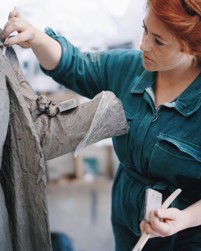When my design was selected for the statue of Nancy Astor on February 14th 2019, I knew I was embarking on quite a journey.

An incredible amount of passion and drive had brought the project to reality and I felt a huge weight of responsibility to create a statue to match. This statue joins a number of other country wide initiatives working to elevate the history of women’s achievements.
Until recently the majority of females represented in statue and architecture have been figureheads or scantily clad allegorical characters. It is incredibly important for real women to be visible and championed for their achievements rather than their physicality.
In recent years the voices of women have risen in the media, with equality and representation taking centre stage in many industries. I think there has been a realisation that this inequality is even in the very fabric of our towns. Recent projects to erect statues of women directly challenge that inherent historic bias
.
A strong and uplifting figure
When I began researching Nancy Astor I was stuck by the strength and power in her story and how little I knew about the first woman to take her seat in the House of Commons. Through adversity, she determinedly held her own and laid the path for women in politics.
Despite being seen as an outsider, not only because of her gender but because she was an American, she won the respect and affection of the people of Plymouth.
Nancy Astor went on to stand for Plymouth Sutton for 26 years, giving a voice to those who could not be heard, in particular women and children all across the country.
One hundred years later women are still underrepresented in all levels of government and broader leadership roles. There remain synergies between what Nancy Astor experienced and needed to overcome and the challenges that impact women today.
I wanted the figure to feel strong and uplifting, focusing on Nancy Astor’s achievements and the powerful step forward this statue represents.
There is movement in the stance but the weight is firmly planted on her front foot. The hand gesture is also key, indicative of her mannerisms it sits between aggression and invitation. I also designed the plinth so it curves and rises up to mirror the surrounding architecture and Plymouth’s naval history, anchoring her to the ground where she inspired and uplifted so many.
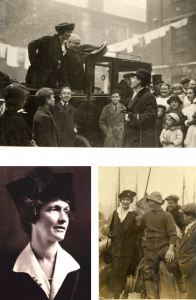
Understanding the subject through archival research
A public portrait of such an established and often controversial figure is a complex undertaking. Elevating one person on a plinth comes with an entanglement of personal history, public perception and historical context.
Understanding as much as possible about the subject, location and time period is key to developing the design. To embody the work with all the narratives it represents is a rewarding balance of research and empathy.
As with many women in the public eye Nancy Astor came under great scrutiny for how she dressed, with her hats being the butt of many a cartoon strip jest. Combatting this she adopted a ‘parliamentary uniform’ as a form of armour with her wide collar white shirts and many hats becoming quite iconic.
I worked closely with the archival team at Reading university, The Box Plymouth and members of her family to select the appropriate items of clothing and jewellery to maintain a level of historical and personal accuracy. Striving to capture the spirit of her character alongside what Nancy Astor represents to people today.
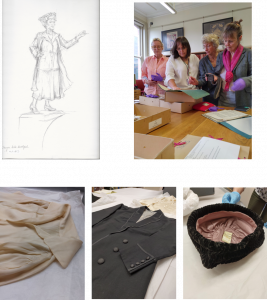
A community project
Tools also play an important part in my physical process, with our constant technological advances there are many ways to produce a sculpture of this scale, I prefer to physically make the work by hand myself. Leaving the makers mark on the surface of the work, embracing the texture and energy this creates.
These marks tell their own story of the sculptures creation, recording the decisions and changes as the piece is pulled into existence.
For the Nancy Astor statue I pushed this process a step further, inspired by the dedication and passion of the community who crowd funded the project, by incorporating them into the sculpture. Using plaster casts of participants hands to imprint into the clay, these identities are woven into the very fabric of the statue.
With the noise and fanfare of the media storm which surrounded the unveiling, this quieter element of the piece seems to grow in significance.
As much as the erection of the statue is about the past with its triumphs and controversies it also stands for every person who champions women’s history. Elevating those individual voices and convocations which go on to influence and change perceptions on a grander scale. A further reflection of Nancy Astor representing those who could not be heard in the House of Commons.
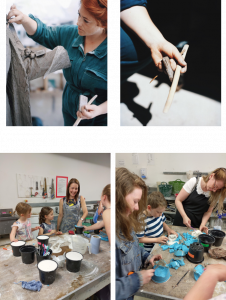
Marking Plymouth’s proud history
Plymouth has embraced Nancy Astor, the statue now stands with strength and resolve looking out over the sound.
I hope that this can be a pin in Plymouth’s proud history as she holds her own in the open landscape of male dominated war memorials. Creating a legacy that continues to ignite discussions and highlight issues that are still very much relevant today.
It would be fantastic if it became a normal occurrence to see women being celebrated for their achievements in public spaces.
As the balance is restored in stone and bronze, perhaps we can look to find more ways to uplift equality.
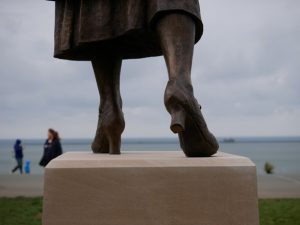

By Hayley Gibbs. Hayley is the sculptor of the Nancy Astor Statue, whose design was chosen by competitive bid. She delivered and installed the statue within 12 months. Hayley is an established sculptor based in South London. She is a member of the Queen Elizabeth Scholarship Trust (QEST) and has created work for some historic sites including a life size bronze statue of William Shakespeare in collaboration with Raphael Maklouf.

